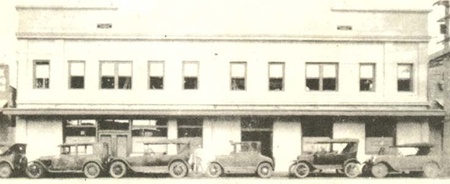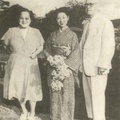Part 2 >>
Makino and the Hawai Hochi
In August 1938, Ryoka Yano wrote:
“The Hawaii Hochi always sided with Japanese immigrants. Fred Kinzaburo Makino never sought money or power. He always expressed his ideas, no matter how difficult the situation was. Therefore, sometimes Makino’s intentions were misunderstood, and he was chastised by society. But he never changed his way, pursuing his ideals and, in the end, he succeeded in convincing people. This was the way of The Hawaii Hochi from its beginnings until today.”
A quick look at back issues of the Hochi would verify Yano’s comments:
- Five teachers from Japan were invited by the Japanese language school operated by the Hongwanji mission, but, on arrival, immigration officials refused to allow them to land. Makino persuaded Yemyo Imamura, president of the mission, to file a complaint in court. Thereafter, Makino obtained landing permits for the five. This established a precedent allowing Japanese language teachers to come to Hawaii without discrimination.
- The Hawaii Hochi worked very hard to obtain citizenship for Japanese soldiers who fought for the United States in the First World War. As a result, about 400 veterans were able to gain citizenship.
- In 1916, 2,000 longshoremen were on strike because the union leadership accepted the membership of 38 Japanese workers. In an editorial, The Hawaii Hochi appealed to plantation workers to organize, and pleaded for unity among the workers of different races. In the same editorial, The Hawaii Hochi also characterized the labor troubles as being basically a conflict between the capitalists versus labor, a radical idea at the time.
- In 1919, The Hawaii Hochi appealed for the unity of Japanese and Filipino plantation workers. Employers would be forced to listen to a strong union, and workers wouldn’t have to go on strike every time they wanted a pay raise or had other demands.
- As the result of these editorials, the Japanese Federation of Labor was organized at the end of 1919. The Federation decided to go strike, a decision Makino opposed, but could not stop. After the strike was called, The Hawaii Hochi took the side of the strikers, but it also criticized the actions of union leadership as reckless, and criticized the way in which the settlement was reached. As a result, the Hochi was forced into a very difficult position in relation to the union. But, after the strike ended in failure, people realized how right the Hochi’s position had been.
- Since around 1919, pressure against Japanese language schools mounted. More and more, discriminatory rules and regulations were ordered by the authorities. In the fall of 1922, Makino proposed to file a suit against those rules and regulations, contending that they violated the Constitution of the United States. Many Japanese intellectuals and influential people, including the Consul General of Japan, tried to stop him, but Makino continued with the suit. Finally, in 1927, the U.S. Supreme Court agreed that the rules and regulations against Japanese language schools were unconstitutional, and allowed Japanese language schools to continue.
- In September 1928, a disturbed Japanese youth named Myles Yutaka Fukunaga kidnapped a white boy and murdered him. The trial was completed within a month after the incident, and Fukunaga was sentenced to death. Makino knew it would be difficult to change the verdict, but he strongly felt that the defendant had not received a fair trial. He personally hired a lawyer and appealed the verdict through the intermediate appeals court and the supreme court. But the appeal was rejected, so Makino pleaded with Gov. Judd for clemency, on the grounds that the youth was obviously mentally disturbed. But Judd refused and Fukunaga was executed in October 1929.
- In September 1931, a rape was reported in Ala Moana by the wife of a Navy officer. Five local youths, one of whom was Japanese were arrested as suspects. During the infamous trial in January 1932, known as the Massie case, one of the defendants was kidnapped and murdered by the husband of the alleged rape victim. In the end, all of the suspects were released for lack of evidence; in fact, whether or not a rape even occurred was called into question.
The four Navy officers who carried out the kidnapping and murder of one of the youths were found guilty and were sentenced to 10 years in prison. But Gov. Judd under pressure from the Navy, invited the four defendants to the governor’s mansion for a tea party, after which he pardoned and released them.
People could not help but to compare the Massie case with Fukunaga case. It was apparent that the treatment of whites versus non-whites was quite different at the time – a double standard of justice. Makino argued that both the U.S.-Japan treaty as well as the U.S. Constitution guaranteed the basic human rights and freedom of the Japanese in Hawaii. He fought discrimination against Japanese whenever it reared its ugly head.
The Makino Legacy
Makino never fought against the United States government or Hawaii’s territorial government without due cause. Whenever he took up a position there was always sound reason that warranted such actions.
Unfortunately, whenever Makino took up an issue, influential leaders within the Japanese community, such as Soga of the Nippu Jiji or Rev. Takie Okamura of Makiki Christian Church, or Dr. Iga Mori almost always argued against him. Often, the Japanese Consul General sided with them in opposition to Makino, saying that he created controversy and divisiveness within the Japanese community. Without Makino, the leadership of the Japanese community in Hawaii would have rested largely with these three men and the future of the Japanese might have been very different indeed.
Makino’s contributions through The Hawaii Hochi to challenge those in authority in order to protect the rights of the common man should rightfully be given its place of honor in the modern history of Hawaii. The open society that we enjoy today became possible in part because of Makino’s struggles, against injustice. Makino encouraged the Japanese in Hawaii to live with pride, a message he repeated time and again, from the very first issue of The Hawaii Hochi:
"There are now in Hawaii many children born here of Japanese parents who, by reason of their birthplace, have all the rights and privileges of the citizens of the United States of America. It will be one of the principal aims of this paper, to afford an opportunity to such young people to learn all the important affairs of the United States, and become familiar with its institutions, so that they may not only enjoy the privileges of citizenship to the fullest extent, but may become patriotic citizens, of intelligence, integrity, and virtue.”
Unfortunately, society tried on numerous fronts to prevent Japanese from becoming American citizens, and many Japanese themselves were not too enthusiastic about becoming U.S. citizens. So rather than be pushed meekly aside, the Hochi challenged young Japanese to face white youths, eyeball-to-eyeball and demand their rightful place in society.
From its inception, The Hawaii Hochi was a bilingual newspaper. Editorials and important articles were translated and published in English. In 1924, The Hawaii Hochi began to publish an English language newspaper call “The Bee,” under the dynamic editorial guidance of George W. Wright. In 1925, the two papers were printed together. Then in 1927,”The Bee” became a section of the Hochi, increasing the number of pages to six pages. There are many elderly Japanese who were greatly stimulated and encouraged by the English section of Hawaii Hochi.
* This article was originally published by the Hawaii Hochi in commemoration of The Hawaii Hochi, Ltd's 75th Anniversary.
© 1987 Hawaii Hochi, Ltd.







